Do you know the difference between die casting and foundry? For many, the terms are often used interchangeably when in fact, they are quite different processes. In this blog post, we’ll explore what sets these two manufacturing techniques apart, how they differ in terms of cost and quality, and which one is right for your project.
Die Casting
Die Casting is a metal-forming process that involves injecting molten metal into a mould cavity under high pressure. The mould cavity is typically made out of steel or aluminium using a precision machining process. The result is an accurate and repeatable part with consistent wall thicknesses and uniform features. This method is commonly used to produce complex components from zinc alloys, aluminium alloys, brass alloys, and magnesium alloys.
Foundry Casting
Foundry Casting is a similar process but uses sand moulds instead of metal moulds. The sand moulds are made from a mixture of silica sand and bonding agents such as clay or wax. This method can be used for both ferrous (iron-based) metals as well as non-ferrous (non-iron-based) metals like aluminium. It also allows for larger parts to be cast than with die casting since sand moulds can be broken down easily after each use.
When it comes to cost, die Casting tends to be more expensive than foundry due to the higher tooling costs associated with creating the metal mould cavities needed for die-casting parts. On the other hand, foundry casting offers more cost savings since it does not require any special tooling and can be done with minimal setup time. In terms of quality, die-cast parts tend to have better dimensional accuracy, while foundry-cast parts offer greater surface finish options due to their ability to create complex geometries without additional machining requirements.
Difference Between Die Casting and Foundry
Cost
One of the primary differences between die casting and foundry is the cost. Die Casting typically costs more than foundry due to the higher level of precision and accuracy required. Additionally, die Casting requires special equipment that can be expensive to purchase and maintain.
Material
Another difference between die casting and foundry is the material that can be used. Die Casting is typically limited to metals such as aluminum, brass, and bronze, while foundries can accommodate a wider range of materials, including iron, steel, and titanium.
Lead Time
The Lead Time is the amount of time required to complete a project from start to finish. Die Casting typically has a shorter lead time than foundry due to the fact that it is a faster process. Additionally, die Casting moulds can be reused multiple times, which further reduces the Lead Time.
Other Differences
- Die casting is a process that uses moulds to create metal parts.
- Foundry is a process that involves melting metal and pouring it into a mould.
- Die casting is typically used for small, intricate parts.
- Foundry is typically used for larger parts.
- Die casting typically has a lower production cost than a foundry.
- Die casting typically has a higher production rate than a foundry.
Conclusion:
In conclusion, when considering whether die Casting or foundry is right for your project, it really depends on what qualities you need out of your end product—such as surface finish or accuracy—and what type of material you’re using for your part design—like iron or aluminium alloys—as well as budget considerations such as tooling costs versus setup time costs. Understanding the differences between these two manufacturing techniques will help ensure that you make an informed decision about which process best suits your needs!

Abhishek is a seasoned blogger and industry expert, sharing his insights and knowledge on various topics. With his research, Abhishek offers valuable insights and tips for professionals and enthusiasts. Follow him for expert advice on the latest trends and developments in the metal industry.




